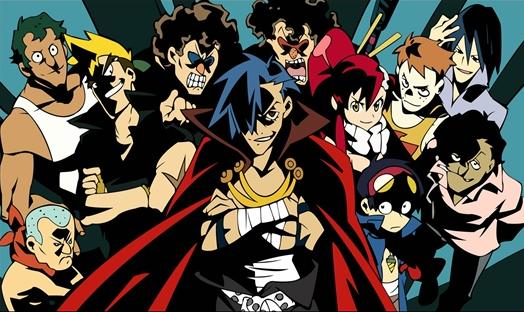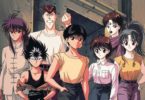As of April 1, 2017, Gainax’s unapologetically over-the-top mecha series Tengen Toppa Gurren Lagann (2007) is officially ten years old. April Fool’s Day gags and geriatric jokes aside, I wanted to take the opportunity to casually reminisce about this well-known anime.
It seems only fitting that the studio behind Neon Genesis Evangelion (1995–1996) would create yet another mecha anime characterized by its upending of conventions. Though, admittedly, TTGL was neither as divisive nor as genre-redefining as Evangelion, in a similar fashion it was rather novel while frequently displaying its own conceptual roots. In terms of aesthetics and premise, elder patrons of Japanese cinema can undoubtedly recognize elements of Mazinger Z (1972–1974) and Getter Robo (1974–1975), while keen-eyed Gainax fans may notice nods to numerous past Gainax productions during episodes like “Sit in the Hot Tub ‘Till You’re Sick!!” in the form of various character lookalikes.
Thematically, callbacks and allusions to Leiji Matsumoto classics such as Space Pirate Captain Harlock (1977–1979) abound, while inspirations for character development include original video animations Gunbuster (1988–1989) and Otaku no Video (1991). Its inclusion of fundamental Shōnen elements aids in its ability to continuously garner popularity (especially from young men), and its unusual take on commonly occurring storytelling tropes—for instance, the extended time skip towards the latter part of the narrative—contributed to its initial critical reception from international audiences.
And speaking of novelty, though humanity being portrayed as the proverbial underdog is nothing new, the series’ bold creative direction of exploring the possible ramifications of its “pierce the heavens” mantra remains noteworthy.
As the story progressively sheds some of its enthusiastic Shōnen trappings, TTGL effectively embraces a more mature tone reminiscent of many Seinen works; the metaphorical passing of the baton from Kamina to Simon perfectly symbolizes the show’s tonal metamorphosis from unbridled naiveté to grizzled acumen. After saving the world as impetuous teenagers, the grown-up members of Team Dai-Gurren have to actually manage the society they fought to create. Eventually, they learn that there are downsides to unchecked progress, and soon find themselves mired in a bona fide progress trap triggered by their rapidly expanding human population. But, as the saying goes, where there’s a will (and a giant robot or two), there’s a way: as far as TTGL is concerned, sheer willpower and faith in friends triumphs over nihilism.
Despite some of its depressing themes and emotional low points, Tengen Toppa Gurren Lagann has forged an identity as the definitive inspirational super robot anime of a generation. And, as with its own previously mentioned inspirations, I believe that Gurren Lagann will be a name long remembered due to its timeless messages of exploration, perseverance, and humanity’s universal need to constantly thrust itself beyond its own self-imposed boundaries.
© 2017







